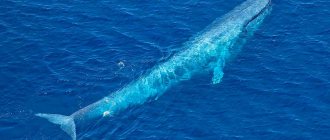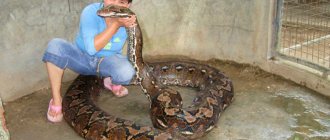Humpback whale
The inhabitant of all oceans except the Arctic Ocean and the adjacent seas belongs to the minke whale family. The average length of its body is 14.5 m, and its weight reaches 30 tons. In rare cases, 18-meter individuals are found, respectively, and their weight approaches 35-36 tons. Distinctive features of the appearance of these whales are warty skin growths, located on the snout and pectoral fins, and an unusually shaped dorsal fin resembling a hump. In addition, they have a special coloring that helps distinguish one individual from another. The humpback whale feeds on crustaceans, fish and mollusks. It is famous for its habit of vigorously jumping out of the water in a vertical position, the meaning of which scientists have not yet figured out.
sei whale
A rare whale of the minke family, it is considered an endangered species. It grows up to 18 m in length, extremely rarely - up to 20 m. Weight reaches 30 tons. It lives in all oceans, avoiding the very cold waters of Antarctica and the Arctic, as well as too warm tropical zones. It tries to stay alone or in pairs; in places where food accumulates, it can join herds of several dozen individuals. The basis of the diet of whales, common in the southern hemisphere, is black-eyed crustaceans. Representatives of northern latitudes eat fish, crustaceans and mollusks.
Gray whale
Whales with a characteristic grayish-brown color are common in the cold, temperate and subtropical waters of the Pacific Ocean. They prefer coastal areas and can stay in shallow water. Here they feed on benthic organisms, scooping them up with their huge mouths along with silt and pebbles and then filtering them through the whalebone. The maximum body length of these sedate giants is 15 m, and their weight does not exceed 35 tons. Gray whales are considered record holders among mammals for covering long distances during seasonal migration; in a year they can swim a distance of 19 thousand km.
Sperm whale
The largest representative of the suborder of toothed whales. It grows up to 20 m in length, and its weight can reach 50 tons. This whale cannot be confused with any other species due to its very striking external differences. His huge head, compressed at the sides and pointed, appears rectangular in profile. It makes up at least a quarter of the total body length. The mouth is located at the bottom of the head, while the jaw moves down 90 degrees. These whales are common in all oceans, only avoiding icy polar waters. They feed mostly on cephalopods; they also eat fish, but in small quantities.
Killer whale victim
However, blue whales can die not only at human hands. The mammal can also become a victim of its marine neighbors. You might think that adult whales, due to their gigantic size, have no natural enemies. However, they may still fall out of favor with killer whales. The latter gather in schools, tear blue whales apart and eat them. And cases of attacks have already been recorded. So, in 1979, a pod of 30 killer whales attacked a young blue whale.
Blue whale. Size
Killer whales rushed at their prey, tearing pieces off it. Moreover, the attackers did not even know where to bite - on the head, sides or back. And in 1990, two large whales were described that were seen in the Gulf of St. Lawrence. They had scars in the form of parallel stripes, judging by them, the mammals had traces of the teeth of killer whales.
Southern right whale
A member of the right whale family. It lives in the southern subpolar and temperate waters of the Atlantic, Indian and Pacific oceans. The length of its body reaches 18 m, and its weight is up to 80 tons. The color of individuals can vary greatly; there are light brown whales and almost black ones. Skin growths on the head, the location of which is unique in each specimen, help identify animals. The southern right whale has a curious and outgoing nature, which previously often made it a relatively easy prey for whalers. After 1937, hunting for this species of whale was prohibited.
Minke whale
The Minke whale rounds out the top ten largest whales on the planet. The minke is dark gray in color, but its belly and pectoral fins are white. It has 230-50 plates of whalebone, yellow-white, sometimes black, and 50-70 throat folds.
The maximum length of adults is 10.7 meters, weight is 5-10 tons. Thanks to its relatively small dimensions, the whale can reach speeds of up to 40 km/h. Dive to a shallow depth and hold your breath for up to 20 minutes. Minka exhale air with an unpleasant odor, which can be felt within a radius of 30 meters.
The Minke whale is one of the smallest members of the minke whale family and a particularly abundant species of whale. Often found in the Atlantic and Pacific oceans, but found in all oceans. They spend the summer in temperate latitudes and migrate to the tropics for the winter.
Representatives of this species of whales move in small groups of 4–5 individuals to collect food together. The Minke whale feeds on plankton, herring, saury, pollock, as well as fish species unusual for whales, such as cod and dog shark.
Minke whales are hunted by whalers in Japan, Iceland and Norway. Up to 1 thousand animals are caught per year, 90% of the total “catch” goes to Japan.
Northern right whale
Belongs to the same family as the southern right whale and is very similar in size and appearance. The body length reaches 18 m and weighs about 80 tons. Its usual habitat is the northern latitudes of the Atlantic Ocean. It feeds on crustaceans and fish, filtering them through whalebone. Whales of this species usually stay near feeding areas in the coastal zone, which has become the reason for their mass extermination. At the moment, the number is only 300-450 individuals. Despite the fact that hunting for these whales has been completely banned, the population is practically not recovering. Every year, researchers record more deaths of northern giants than births of babies.
How does it reproduce
To reproduce, these mammals prefer to go to warm waters. Even the inhabitants of colder regions move to warmer conditions, this happens in winter.
The gestation period in mammals lasts from 9 to 16 months, the exact time depends on the species. Most often, only one baby is born, and it is born tail first. The baby whale then floats to the surface and breathes air into its lungs for the first time. Quite quickly, the offspring acquires swimming skills, as well as life skills in a new environment. A newly born whale practically does not swim away from its mother since it is much easier for them to swim and defend themselves from all rivals of any size. The offspring are born quite large, and also have a formed body, allowing them to easily adapt to new living conditions. Cetaceans have this opportunity due to the absence of pelvic bones; because of this, the size of the baby whale is not limited in any way.
@ Pexels - pixabay.com
The cubs feed very often; about fifteen minutes pass between feeding periods. The feeding process is quite simple - thanks to the contraction of special muscles, the milk itself is injected into the baby whale’s mouth. Its quantity varies from 250 ml to 250 liters at a time, it all depends on the size of the baby.
Unlike cow's milk, whale milk is many times more nutritious, and in concentration it is more reminiscent of thick sour cream. Thanks to this, it does not blur in water. Cubs begin to eat on their own at least four months after birth; this period can last up to a year, depending on conditions. Sometimes a baby whale needs to feed on its own earlier because the mother is expecting another replenishment, and no one gives him the right to choose.
Thanks to a well-developed parental instinct, offspring are almost never left alone and do not find themselves in life-threatening situations. Even if the tide is low, the mother will wait for the tide to rescue her baby. Parents of all bravely rushed to save their children who fell into the hands of whalers, they never need to say “choose your life or the life of a child”, the answer to the question is known in advance.
This was successfully used by people who caught adult mammals in this way. Caught animals were used not only for fat, bones and meat. Beluga whales can be found quite often in a circus on the water or in a dolphinarium, so this breed is the most valuable for whalers. Most often, cubs are hunted, since it is easier to teach them a variety of tricks, and also not to worry about the flashes of cameras taking photos of the performance.
The mutual assistance of these animals is at its best. They treat both their offspring and the whales of their brothers with equal reverence. They are always ready to come to the rescue and save a wounded relative or try to do so. Weak individuals (due to injuries or illnesses) are helped by their healthy counterparts. They surround their comrade and lift him to the surface of the water.
Japanese whale
Another representative of the right whale family, it differs from its southern and northern relatives in its larger size: body length can reach up to 18.5 m, weight – up to 80 kg. It lives in the northern part of the Pacific Ocean, the birth of cubs occurs off the coast of Japan. Like other right whales, the Japanese right whale has been intensively hunted, pushing the species to the brink of extinction. At the moment, there are approximately 500 individuals left in the world. Population recovery is proceeding at an extremely low rate, since females are ready for reproduction only at the age of 6 to 12 years and give birth to only 1 baby every 3-4 years.
Almost bipedal
There is a theory according to which whales came into the water from land.
Proof of this is the structural features of the skeleton of a mammal, which does not really resemble a fish. The blue whale even has tufted fingers on its fins. Moreover, the blue whale does not lay eggs or spawn; it produces already living organisms. Blue whale in nature It is worth noting that whales have a very poor sense of smell and vision. Therefore, the largest whale in the world communicates with its fellow whales exclusively through sounds. And in order for other mammals to hear the cry, the whale has to put up to 20 hertz into the message. And this is enough to transmit information over a huge distance - individuals are able to hear each other at a distance of up to 800 kilometers and even more. However, if the whale overdoes it and screams with more or less force, then its brothers will not hear it. And whales are not capable of understanding anyone. For the most part, these mammals are loners. The blue whale, as a rule, does not form herds.
But sometimes mammals still gather in groups, but they are not numerous, only 2-3 heads. Only where there is a lot of food can large aggregations be found. However, even in such groups, blue whales stay apart from each other. The largest whale in the world has been caught. The mammal is not as maneuverable as other large cetaceans. Whales' movements are slow and clumsy. And they are active only during the daytime, this is evidenced by the fact that, for example, off the coast of California, individuals stop their movements at night. In general, the life of blue whales at night is still little studied.
Fin whale
Refers to minke whales. Distributed in all oceans, it does not even avoid the waters of the Arctic and Antarctic. Stays away from coastal areas and does not migrate from the southern to the northern hemisphere or vice versa. For this reason, some scientists distinguish 2 subspecies of these whales: northern and southern. Residents of northern latitudes are usually smaller, their maximum length is 24 m. Southern representatives of fin whales grow up to 27 m, and their weight can approach 70 tons. The basis of the diet of these whales is planktonic crustaceans, less often fish. Like many other cetacean species, fin whales are endangered. In most countries of the world, hunting them is prohibited.
bowhead whale
The largest of the right whale family, the only representative of the genus Balaena, has chosen the polar regions of the Northern Hemisphere. He tries not to be directly among the ice, but when this does happen, he makes his way, splitting ice floes up to 22 cm thick. The body length of female whales of this species reaches 22 m, and their weight is 150 tons. Due to such impressive dimensions, they swim very slowly, at a speed of about 20 km/h. Such slowness made whales easy prey for whalers, since they could catch up with the giant even in an ordinary rowing boat. Hunting bowhead whales is now prohibited. According to scientists, there are about 10,000 individuals in the modern population.
Social structure and reproduction
Photo: Blue whale calf
To communicate with other whales, powerful infrasound signals with a frequency of about 10-20 Hz are used. With their help, vomits can make themselves known to relatives swimming at a considerable distance.
These animals are monogamous, and established pairs swim together for many years. Once every two years, a baby whale appears in such pairs; before this, the female carries it for almost a year. A newborn is fed very high-fat milk for a little more than six months, and on a milk diet gains hundreds of kilograms every day.
As a result, it very quickly grows to impressive sizes, reaching 20 tons or even more weight. They are fertile from the age of 4-5, but even after this period the growth process continues - it continues until they are 15 years old.
Researchers' opinions on the life expectancy of vomiting whales vary. The minimum estimate is 40 years, but according to other sources they live twice as long, and long-livers even exceed a hundred years. Which estimate is closer to the truth has not yet been established for certain.
Vomits are the loudest living creatures. They are even louder than an airplane jet engine! Relatives can hear their songs at a distance of hundreds and even thousands of kilometers.











